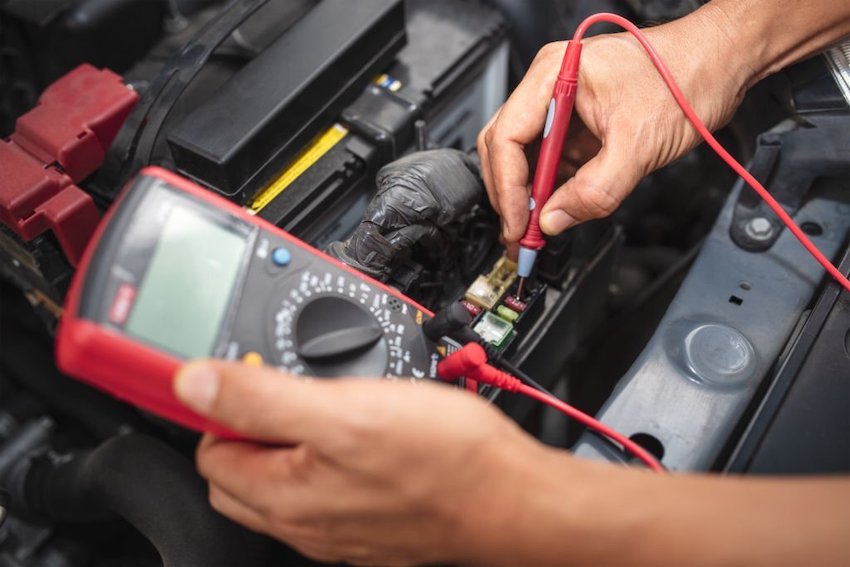A wrong voltage reading on a car battery is common. This sometimes means the battery will read well, but it would be bad. And unless you’re paying attention to your car, you might end up with a serious breakdown.
This article will discuss some of these bad battery occurrences and how to fix them before they affect your car.
Is It Possible for A Battery to Read 12V and Still Be Bad?
A battery could show a voltage higher than 12 volts and still be bad. If it is bad, it will die or drop significantly when put under load.
If the battery measures 12V with no load, it is bad or badly in need of a charge. If it reads 10.5V or less when under starter load, you need a new battery.
So, can a car battery read good but be bad? Yes, without a load, a faulty battery may read 12+volts. But the voltage under a load is what matters.
When you try to start the car with a dead battery, the lights will become extremely dim.
As long as the battery voltage remains above 9.6 volts, the battery is considered “good”. But if it drops below 9.6 volts by the end of the test, the battery may be bad. Try to recharge the battery and see if it will work.
Resting fully charged 12-volt batteries are around 12.8-12.9 volts, and flat dead ones are at 12.0 volts, so 12.4 volts on a resting battery means it’s about 50% charged.
A fully charged battery will normally register between 12.6 and 12.8 volts on a voltmeter. If the voltage on your voltmeter is between 12.4 and 12.8, your battery is in good health. Any voltage more than 12.9 volts is a sign that your battery has excess voltage.
Why Does A Car Battery Show Wrong Readings?
Most of the time, you will get wrong readings when the battery is under severe conditions. This could include the intense heat of the load. When the battery is under such conditions, the weld pieces connecting together the battery cells separate or become loose. As a result, the current on the battery will be cut or reduced.
However, the loose piece will touch when the battery cools off, giving an incomplete connection. And if the battery has open cells, it will read fully charged when left idle. But the battery will fail to work when you start your car or put it under any load.
Once your battery starts behaving this way, it’s completely damaged. You should get it replaced immediately. You can get a new battery or recycle the bad one.
How to Use a Multimeter to Check a Car Battery?
When your vehicle fails to start, it’s usually due to a low or dead battery. However, most car owners do not inspect their batteries until they fail.
Conducting a car battery voltage test using a multimeter regularly – at least twice a year – is recommended as a preventative maintenance technique. You’ll notice any issue before the battery gets damaged.
The following are simple steps to test your battery with a multimeter.

Step 1: Preparing the battery
The first step is to find the car battery (see the owner’s handbook) and inspect the positive and negative terminals for dirt or corrosion.
The positive terminal is commonly identified by a red cover with a “plus” symbol, whereas a black cover identifies the negative terminal with a “minus” sign.
Corrosive buildup should be scraped away with fine-grit sandpaper to prevent the multimeter from taking correct voltage measurements.
To protect the skin from dangerous chemicals and battery acid, gloves should be used. After the terminals have been cleaned, they will be used to connect the multimeter’s probes.
Step 2: Setting Up the Multimeter
The multimeter’s different measurement settings make it appear sophisticated, yet the overall operation is straightforward. The multimeter dial should be set to “20 volts” to evaluate the electrical output from a car battery.
However, before using the multimeter, all surface charges from the battery must be removed to get an accurate result. To do this, turn the headlights on for about two minutes before turning them off.
Step 3: Measuring and Analyzing
The multimeter includes two probes for monitoring battery load: red and black. Red is for the positive and black for the negative probe.
The multimeter display should show a reading of 12.2 to 12.6 volts when the probes touch the terminals when the automobile is turned off, and the battery is resting (full charge).
This voltage range indicates that the battery is capable of starting the car. If the recorded voltage is less than 12.2 volts, the battery’s resting voltage is low, indicating that it should be charged or replaced.
It’s time to get a reading on the crank cycle once the resting voltage has been determined. Because of the increased quantity of energy required to run the starting motor, this is the time when the car is turned on, and the battery is under the most strain.
A second person will be required to start the ignition in order to obtain this reading. The voltage measurement will dip for a brief while when the car is turned on, but it should not go below 10 volts.
If the voltage drops below 10 volts, the battery has insufficient turnover strength and is likely to fail. The battery may also need to be recharged or replaced in this instance.
The car will begin to idle immediately after the crank cycle and sustain a constant draw from the battery. The multimeter reading should be between 14 and 14.5 volts when the motor operates.
When the battery voltage drops below 14, it signifies the alternator is malfunctioning, or the battery is weak and unstable for long-term vehicle operation.
While the car runs, the alternator’s purpose is to create energy to feed the electrical system and charge the battery.
Step 4: Testing the Alternator
Turn on the vehicle’s electrical equipment, including the headlights, interior illumination, climate controls, and audio, to test the alternator. The voltage load will be maximized as a result of this.
If the multimeter reading falls below 13.5 volts, the alternator is not charging the battery adequately and may need to be replaced. It’s time to get a second opinion from a certified professional.
A multimeter can give its owner crucial information about a vehicle’s battery and electrical system. Periodic testing can aid in predicting and preventing impending failures, which frequently occur without notice.
What Does the Battery Light Indicate?
The battery light on your device does not signal an issue with the battery. When you start your automobile, it’s common for the battery light to come on and then go out.
However, if it turns on while driving, it’s a clear sign that something is wrong with your charging system, which is usually the cause of a malfunctioning alternator.
The work of your battery is to start the automobile; your alternator is responsible for generating the electricity that keeps it running and recharges the battery.
Conclusion
Can A Car Battery Read Good But Be Bad? Yes. Depending on the conditions of your battery, it might show wrong readings. So, when your battery shows that the battery is okay, but your car doesn’t function normally, it’s advisable to inspect the battery manually. This will ensure that you get the right readings from your car battery.

